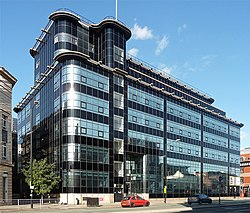Our website is made possible by displaying online advertisements to our visitors.
Please consider supporting us by disabling your ad blocker.
Daily Express Building, Manchester
| Daily Express Building | |
|---|---|
Express Building | |
 Front façade visible from Great Ancoats Street | |
| General information | |
| Type | Office and residential |
| Architectural style | Futurist Art Deco Streamline Moderne |
| Location | Great Ancoats Street, Ancoats, Manchester |
| Country | England |
| Coordinates | 53°29′06″N 2°13′53″W / 53.4849°N 2.2313°W |
| Construction started | 1936 |
| Completed | 1939[1] |
| Renovated | 1960 (extension)[2] 1979 (two-storey extension)[2] 1983[2] 1993–95 (office conversion)[2] 2018 |
| Dimensions | |
| Diameter | 75,600 square feet (7,020 m2) |
| Technical details | |
| Structural system | Steel and glass (curtain wall) |
| Floor count | Six-storeys |
| Design and construction | |
| Architect(s) | Sir Owen Williams |
| Civil engineer | Sir Owen Williams |
| Designations | |
Listed Building – Grade II* | |
| Official name | Daily Express Building |
| Designated | 2 October 1974 |
| Reference no. | 1218285 |
The Daily Express Building, located on Great Ancoats Street, Manchester, England, is a Grade II* listed building which was designed by engineer Sir Owen Williams. It was built in 1939 to house one of three Daily Express offices; the other two similar buildings are located in London and Glasgow.
The pre-World War II building is notable for its timeless, "space-age"[3] quality and is often mistaken for being much younger than it is due to its futuristic avant garde appearance.[4] The building is futurist art deco, specifically streamline moderne with its horizontal lines and curved corners. It is clad in a combination of opaque and vitrolite glass. It was considered highly radical at the time, and incorporates what was at the time a growing technology, curtain walling.[5]
Unlike the London and Glasgow Express buildings, the Manchester building was designed by the engineer for all three buildings, Sir Owen Williams.[6] It is considered the best of the three Express Buildings,[7][8] and is admired by architects (such as Norman Foster)[9] and Mancunians alike.[10][11] The building was Grade II*-listed in 1974, just 35 years after its initial construction, and remains Greater Manchester's youngest II*-listed building.[12]
- ^ Urban Memory :History and Amnesia in the Modern City. Mark Crinson. 2005. ISBN 9780415334051.
- ^ a b c d "Hartwell, Clare (2002). Pevsner Architectural Guide - Manchester. Penguin. p. 285. ISBN 0-300-09666-6.
- ^ Martin, Rob (27 January 2015). "Manchester's Modernist marvels". timeout.com. Retrieved 14 March 2015.
- ^ "Manchester Architecture part three". Manchester Confidential. 21 April 2010. Retrieved 8 December 2011.
First time visitors to the city frequently wonder if it was built within the last decade
- ^ "The ascent of Manchester". The Daily Telegraph. 24 May 2002. Retrieved 8 December 2011.
For the first time since 1939, when Sir Owen Williams built his Daily Express building, it is possible to turn to Manchester not with a shudder but with keen anticipation.
- ^ Cite error: The named reference
ioewas invoked but never defined (see the help page). - ^ "Daily Express, Manchester". Engineering Timelines. Archived from the original on 4 February 2016. Retrieved 9 December 2011.
- ^ "Daily Express Building London: Fleet Street". e-architect.co.uk. 6 March 2014. Retrieved 21 March 2014.
The Express Building in Manchester (1939) is considered the best of the three due to its superior exterior design and better site and was the only one of the three to be designed by Sir Owen Williams.
- ^ "Manchester Express Building" (PDF). GVA Grimley. Archived from the original (PDF) on 5 April 2012. Retrieved 9 December 2011.
The building has been described by Sir Norman Foster as one of his top five favourite buildings in the world
- ^ "Top 5 Buildings". visitmanchester.com. Archived from the original on 17 July 2011. Retrieved 9 December 2011.
- ^ "The Best Buildings in Manchester (as voted by you)". prideofmanchester. Retrieved 9 December 2011.
- ^ Historic England. "Daily Express Building - Manchester (1218285)". National Heritage List for England. Retrieved 3 October 2012.
Previous Page Next Page


